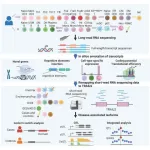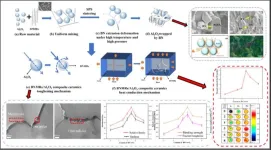(Press-News.org) Ubiquitous wearable technologies, like smartwatches, could help researchers better understand progressive neurological disorders like Parkinson’s disease and speed up the approval of new therapies, a critical need given that no drugs exist to slow progression of the world’s fastest growing brain disease.
New research appearing today in the journal njp Parkinson’s Disease adds to growing evidence that widely used and user-friendly consumer devices, in this instance an Apple Watch paired with an iPhone, can detect changes in Parkinson’s symptoms over time in individuals in the early stages of the disease.
“Digital measures hold the promise to provide objective, sensitive, real-world measures of disease progression in Parkinson’s disease,” said Jamie Adams, MD, an associate professor of Neurology at the University of Rochester Medical Center, the Center for Health + Technology, and lead author of the study. “This study shows that data generated by smartwatches and smartphones can remotely monitor and detect changes in multiple domains of the disease. These digital assessments could help evaluate the efficacy of future therapies.”
“On behalf of Critical Path Institute, we are delighted to see the astounding progress of this unique project,” said Diane Stephenson, PhD, executive director of Critical Path for Parkinson’s consortium and co-author of the study. “The early and often feedback from regulators have shaped this study in ways that now can link the clinical meaningfulness of symptoms measured by digital health technologies to the voice of people with lived experience. By partnering with patients, regulators, industry, and academic experts this project is serving as a precedent for other disease areas to follow.”
Parkinson’s is a complex disease, and the onset and severity of symptoms and progression varies widely from patient to patient. Traditional tools employed to track the disease are often subjective and collect information episodically during clinic visits. As a result, these tools do not adequately portray the day-to-day experience of individuals with Parkinson’s, limitations that have contributed to the slow pace of new therapies.
In contrast, smartwatches and smartphones can passively monitor many of the symptoms of the disease, such as gait and tremor. Additional information can be collected through tasks such as finger tapping and voice recording to measure speech-related symptoms. Adams and her colleagues recently demonstrated the devices could detect differences between individuals with early, untreated Parkson’s and age-matched controls.
In the new study, called WATCH-PD, the researchers followed participants with early-stage Parkinson’s for 12 months. Over the course of the year, the data collected by the devices showed that participants with early Parkinson’s experienced significant declines in measures of gait, an increase in tremor, and modest changes in speech. The smartwatch was able to detect decreases in arm swing, a common clinical feature of the disease, and activity in the form of the number of daily steps. The progression of symptoms in individuals in the study was consistent with other long-term studies of the disease.
The study was designed to replicate a multi-center clinical trial in individuals with early and untreated Parkinson’s disease and involved the participation and input from the pharmaceutical industry, regulators, investigators, and individuals with disease. The WATCH-PD study has recently been extended with support from the Michael J. Fox Foundation and will follow participants for an additional 18 months.
“This study brings us closer to having meaningful digital measures for future use in Parkinson’s clinical trials, which may speed up therapeutic development and get treatments to our patients faster.” said Adams.
Additional authors include Ray Dorsey, Melissa Kostrzebski, Peggy Auinger, Peter Wilmot, Yvonne Pohlson, and Stella Jensen-Roberts with URMC; Tairmae Kangarloo, Yishu Gong, Vahe Khachadourian, Brian Tracey, Dmitri Volfson, and Robert Latzman with Takeda Pharmaceuticals; Martijn Müller with the Critical Path Institute; Joshua Cosman with AbbVie Pharmaceuticals; Jeremy Edgerton with Biogen; David Anderson and Allen Best with Clinical Ink; and the Parkinson Study Group Watch-PD Study investigators and collaborators including Christopher Tarolli from URMC. The research was supported with funding from Biogen, Takeda, and the members of the Critical Path for Parkinson’s Consortium.
END
Smartwatches offer window into Parkinson's disease progression
2024-06-12
ELSE PRESS RELEASES FROM THIS DATE:
What the geologic record reveals about how oceans were oxygenated 2.3 billion years ago
2024-06-12
About 2.5 billion years ago, free oxygen, or O2, first started to accumulate to meaningful levels in Earth’s atmosphere, setting the stage for the rise of complex life on our evolving planet.
Scientists refers to this phenomenon as the Great Oxidation Event, or GOE for short. But the initial accumulation of O2 on Earth was not nearly as straightforward as that moniker suggests, according to new research led by a University of Utah geochemist.
This “event” lasted at least 200 million years. And tracking the accumulation of O2 in the oceans has been very difficult until now, ...
Incidence of dementia before age 65 years among World Trade Center attack responders
2024-06-12
About The Study: In this cohort study of World Trade Center responders who survived these unique exposures and participated in a longitudinal follow-up study of cognition from 2014 through 2022, when compared with responders with the lowest exposure levels or responders who used personalized protective equipment (PPE), more severe exposure to dust or debris was significantly associated with a higher risk of dementia before 65 years of age. This study suggests that the reliable use of PPE might help prevent the onset of dementia before age 65 years among individuals exposed to an uncontrolled building collapse. Future ...
Neighborhood deprivation and breast cancer mortality among Black and white women
2024-06-12
About The Study: Neighborhood deprivation was associated with increased breast cancer mortality among non-Hispanic white women in this cohort study. Neighborhood racial composition, residential mobility, and rurality did not explain the lack of association among non-Hispanic Black women, suggesting that factors beyond those explored here may contribute to breast cancer mortality in this racial group.
Corresponding Author: To contact the corresponding author, Lauren E. Barber, Ph.D., email lauren.barber@emory.edu.
To access the embargoed study: Visit our For The Media website at this link https://media.jamanetwork.com/
(doi:10.1001/jamanetworkopen.2024.16499)
Editor’s ...
Hybrid work is a “win-win-win” for companies, workers
2024-06-12
It is one of the most hotly debated topics in today’s workplace: Is allowing employees to log in from home a few days a week good for their productivity, careers, and job satisfaction?
Nicholas Bloom, a Stanford economist and one of the foremost researchers on work-from-home policies, has uncovered compelling evidence that hybrid schedules are a boon to both employees and their bosses.
In a study, newly published in the journal Nature, of an experiment on more than 1,600 workers at Trip.com — a Chinese company that is one of the world’s largest online travel agencies — Bloom finds that employees who work from home ...
Inherited genetic factors may predict the pattern of X chromosome loss in older women
2024-06-12
hat: Researchers have identified inherited genetic variants that may predict the loss of one copy of a woman’s two X chromosomes as she ages, a phenomenon known as mosaic loss of chromosome X, or mLOX. These genetic variants may play a role in promoting abnormal blood cells (that have only a single copy of chromosome X) to multiply, which may lead to several health conditions, including cancer. The study, co-led by researchers at the National Cancer Institute, part of the National Institutes of Health, was published ...
Study on fruit flies could benefit eggs of older women
2024-06-12
A Dartmouth study conducted on fruit flies reports the first evidence in any organism that oocytes—the cells that become eggs—regularly rejuvenate the critical protein linkages that bind chromosomes together. The findings are a potentially important step toward helping women reduce their risk of pregnancy complications as they age, the researchers report in the journal Current Biology.
Women are born with the oocytes they will have for life, and the cohesive linkages that connect chromosomes are established in those cells prenatally. When they reach childbearing age, ovulation triggers the ...
Climate change-related disturbances linked to worse cardiovascular health, researchers show
2024-06-12
BOSTON – Cardiovascular disease (CVD) is the leading cause of death worldwide, accounting for approximately one in every three deaths, with more than 20 million deaths reported in 2021 according to a 2024 World Heart Federation report. Improvements in heart disease prevention, treatment and intervention have led to substantial declines in cardiovascular deaths in recent decades, but climate change caused by the continued combustion of fossil fuels may undermine this progress. Over the last century, NASA confirms the average global temperature has risen by more than two degrees Fahrenheit, leading to long-term shifts in average weather patterns, disturbance ...
Groundbreaking study uncovers new insights into alternative splicing and disease associations
2024-06-12
Tokyo Medical and Dental University (TMDU) researchers harness long-read RNA sequencing to decode genetic intricacies and disease links.
Tokyo, Japan – Alternative splicing, a process where a single gene can give rise to multiple different proteins via inclusion or exclusion of certain segments of the gene sequence, is known to occur in over 90% of human genes. This leads to the production of numerous transcript isoforms (splice variants of an expressed gene) crucial for protein function and cellular processes. Despite previous research on mechanisms underlying alternative splicing ...
A review of high-performance cementitious composites in bridge deck durability
2024-06-12
Many modern bridges use orthotropic steel bridge decks (OSBD), the decks being the surface sections of the bridge. OSBDs were designed to be lightweight and economical. However, this design has shown increasing issues with pavement cracking and fatigue damage at the welds that connect the bridge deck to the bridge superstructure. Fatigue damage is damage that accrues over time with use.
To ameliorate these problems, a new bridge deck was designed. The composite bridge deck system (CBD) added a layer of concrete to decrease the probability of damage due to fatigue. More recently the use of high-performance materials, such as ultra-high-performance ...
Boron nitride microribbons strengthened and toughened alumina composite ceramics with excellent mechanical, dielectric, and thermal conductivity properties
2024-06-12
In recent years, the high complexity of integrated devices has made heat accumulation increasingly critical and has resulted in higher heat dissipation requirements for substrates and packaging materials. In this study, boron nitride microribbon (BNMR)/Al2O3 composite ceramics are prepared using spark plasma sintering (SPS). This study examines the effect of varying the amount of toughened phase BNMR on the density, mechanical properties, dielectric constant, and thermal conductivity of BNMR/Al2O3 composite ceramics while also exploring the mechanisms behind the toughening and increased ...


